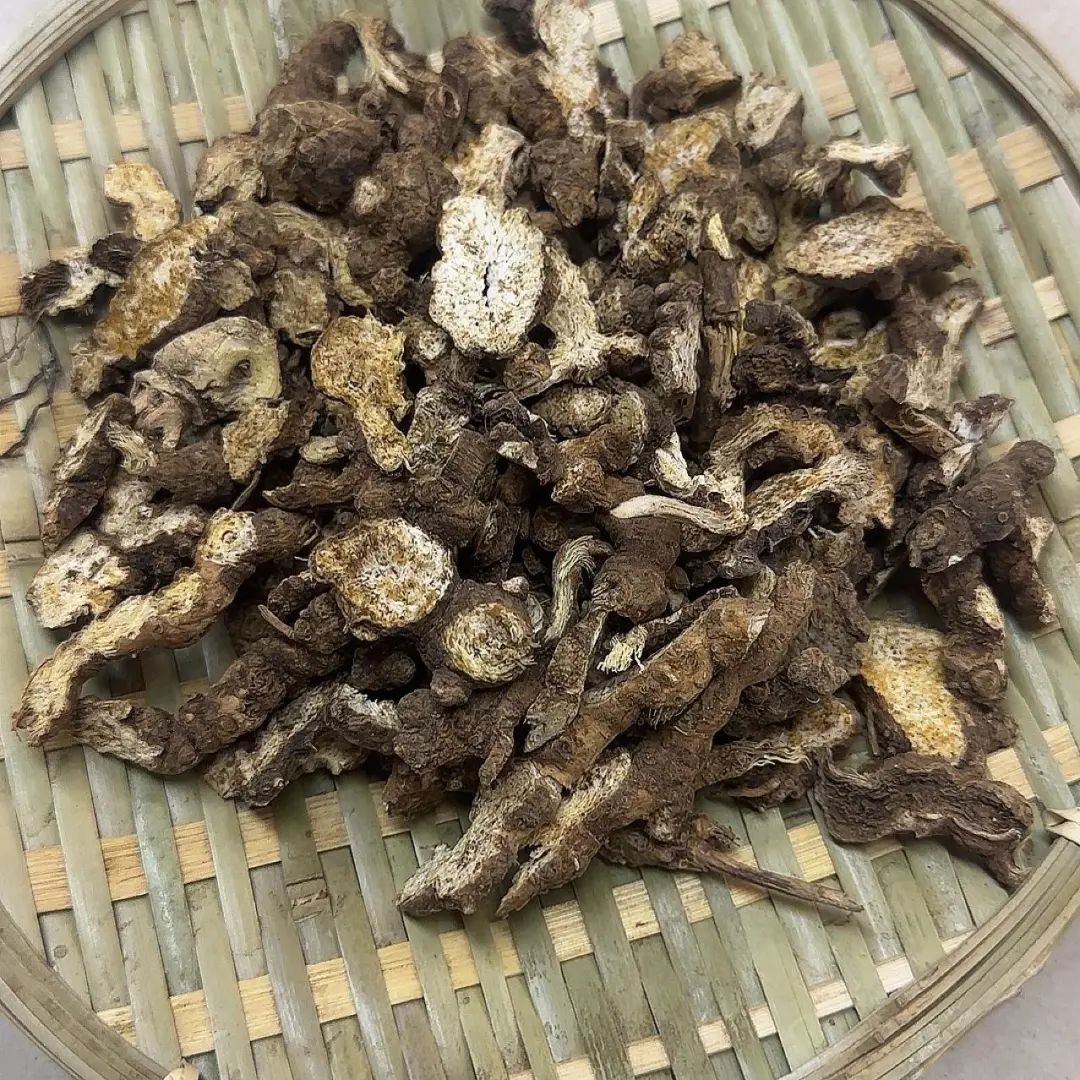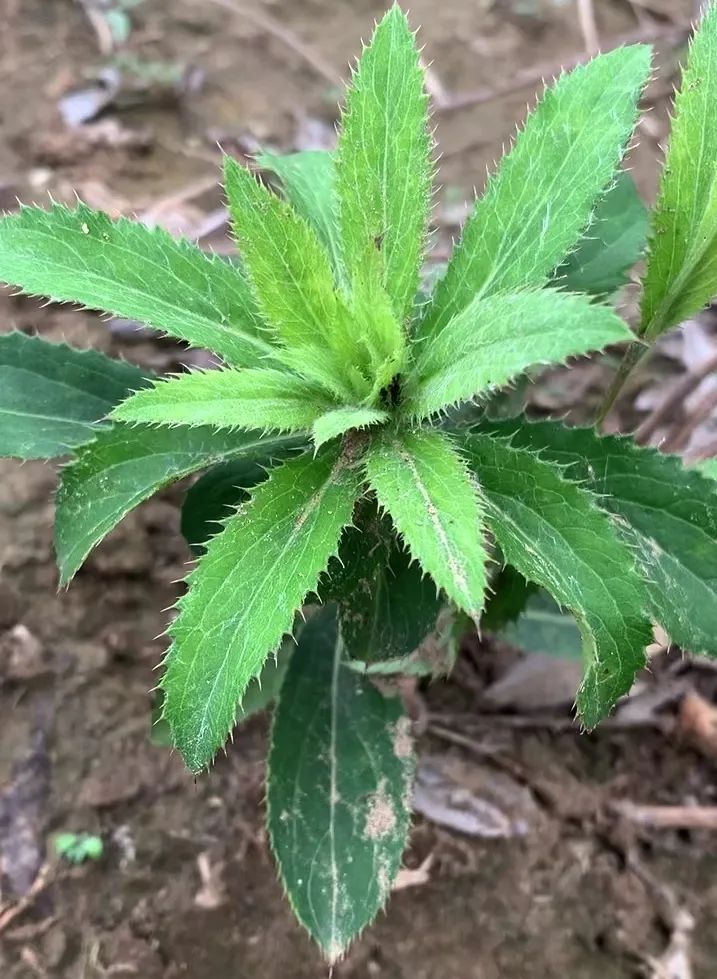Baicao Traditional Chinese Medicine

Learn a little every day for better health every day
Introduction, Efficacy, and Dosage of Cang Zhu (Atractylodes)
Traditional Chinese Medicine is a treasure of the Chinese nation
Over 5000 types of medicinal materials are introduced, sharing the efficacy and functions of one herb daily to help more people understand the knowledge of Chinese medicinal materials~~~
Spreading knowledge of Chinese medicine and promoting TCM culture!

Medicines are a common choice for treating diseases. For different individuals suffering from illnesses, it is essential to select appropriate medications for treatment, which can significantly aid in the improvement of the condition. Each herb can treat multiple diseases, but the choice of medication varies according to the type of disease in the body. Cang Zhu is an excellent choice for treating diseases; what are its functions and efficacy?
Cang Zhu’s Efficacy
Cang Zhu has the effects of drying dampness, strengthening the spleen, and dispelling wind-dampness. It is indicated for damp obstruction in the middle jiao, wind-cold-damp bi syndrome, swelling and pain in the knees and feet, weakness and atrophy, and night blindness. The “Pearl Bag” states: “It can strengthen the stomach and calm the spleen; no other can eliminate all damp swellings.” The “Compendium of Materia Medica” says: “It treats damp phlegm retention… and spleen dampness leading to turbid discharge and slippery diarrhea.” The “Newly Revised Materia Medica” mentions its ability to “promote urination.”
1. Tao Hongjing: Eliminates evil qi.
2. Liu Wansu: Brightens the eyes and warms the water organs.
3. “Pearl Bag”: Can strengthen the stomach and calm the spleen; no other can eliminate all damp swellings.
4. Li Gao: Eliminates dampness and induces sweating, strengthens the stomach and calms the spleen, a vital herb for treating atrophy.
5. Zhu Zhenheng: Dispels wind and benefits qi, resolves all stagnation.
6. “Compendium of Materia Medica”: Treats damp phlegm retention, or with blood stasis forming a mass, and spleen dampness leading to turbid discharge and slippery diarrhea.
7. “Yuqiu Medicine Explanation”: Dries the earth and benefits water, eliminates phlegm and dampness, moves blood stasis, opens stagnation, removes leakage, transforms masses, eliminates symptoms, regulates acid reflux and removes corruption, dispels miasma and pestilence, relieves weakness in the muscles and bones, and clarifies turbid urination.
8. “Materia Medica Seeking Origins”: Stops watery diarrhea, treats food stagnation and summer heat diarrhea, and spleen dampness leading to blood discharge.
9. “Medical Enlightenment”: Cang Zhu is treated similarly to Bai Zhu (White Atractylodes), but for eliminating upper dampness and inducing sweating, its effect is greatest; for tonifying the middle jiao and eliminating dampness, its strength is less. “Essential Prescriptions for Treatment” states: Its use is similar to Bai Zhu, but compared to Bai Zhu, it has a heavier qi and denser body. For swelling in the legs and feet, it can be used with Bai Zhu soaked and scraped off the skin. 10. Li Gao: “Materia Medica” only mentions Zhu, without distinguishing between Cang and Bai, but Cang Zhu has a unique strong upward-moving qi that can eliminate dampness and stabilize the Taiyin, preventing evil qi from entering the spleen. Because it is processed by soaking and frying, it can induce sweating, which is distinct from Bai Zhu’s ability to stop sweating; thus, they cannot be substituted for one another, as they have different properties, while other indications are the same.
11. “Ren Zhai’s Direct Prescriptions”: If the spleen essence is not retained, leading to continuous leakage of turbid urination, and soreness in the lower back, Cang Zhu should be used to consolidate the spleen essence, as essence is produced from grains.
12. Zhu Zhenheng: Cang Zhu treats dampness, applicable to all three jiao (upper, middle, lower). It can also resolve all stagnation, including phlegm, fire, dampness, food, qi, and blood stagnation, all caused by abnormal transformation and failure to ascend or descend, with the disease located in the middle jiao. Therefore, the herb must have both ascending and descending properties; to open it, it must first descend, and to descend, it must first ascend. Thus, Cang Zhu is a medicine of the Yangming meridian, with a pungent and strong flavor, enhancing the stomach and strengthening the spleen, promoting the qi of grains, and can directly enter various medicines, dispelling the dampness of Yangming, facilitating movement and astringency. Xiang Fu (Cyperus rotundus) is a medicine that quickly descends qi, and with its rapid action, it balances the stagnation.
13. “Compendium of Materia Medica”: Zhang Zhongjing used it to dispel all evil qi, burning it with pig hoof shells to create smoke. Tao Yinjian also stated that Zhu can eliminate evil qi and avert disasters, hence nowadays during epidemics and at the beginning of the year, families often burn Cang Zhu to ward off evil qi.
14. “Materia Medica Comprehensive” states: Cang Zhu, broadens the middle and induces sweating, its efficacy surpasses Bai Zhu, tonifying the middle and eliminating dampness, but its strength is not as great as Bai Zhu. Generally, the lower soil should be paired with Bai Zhu for nourishment, while the higher soil should be paired with Cang Zhu for balance.
15. “Materia Medica Justice”: Cang Zhu, with a warm and dispersing nature, can induce sweating and broaden the middle, regulate the stomach, promote appetite, relieve abdominal distension and pain, treat cholera and vomiting, resolve all stagnation, expel cold and dampness, and reduce swelling. Its drying nature treats cold dysentery, cold diarrhea, slippery diarrhea, and cold damp sores. When decocted with Huang Lian (Coptis chinensis), it is most effective in expelling lower jiao damp-heat and atrophy. However, only the Maoshan variety has a firm and small quality, with a sweet and mellow flavor, providing many benefits, greatly surpassing other types.
16. “Pharmaceutical Chemical Meaning”: Cang Zhu, with a pungent flavor, primarily disperses, is warm and dry, can eliminate dampness, and specifically enters the spleen and stomach, treating wind-cold-damp bi syndrome, miasma and pestilence, and skin edema, all due to its pungent and fierce ability to dispel evil. It governs the dampness of the three jiao; if dampness is in the upper jiao, it easily produces damp phlegm, thus it dries dampness and moves phlegm; if dampness is in the middle jiao, it stagnates qi and causes diarrhea, thus it broadens the middle and strengthens the spleen; if dampness is in the lower jiao, it causes weakness in the legs and knees, thus it can be used with Huang Bai (Phellodendron) to treat atrophy, enabling strength in the legs and knees; taking its pungent and dispersing qi, it is used to dispel evil and induce sweating, providing great relief. Combined with Liu Shen San (Six Gods Powder), it can alleviate spring and summer damp-heat diseases; paired with Chai Hu (Bupleurum) and Ge Gen (Pueraria), it can disperse the exterior in the early stages of malaria; if a febrile disease has been treated with sweating and the heat remains unresolved, it can be added to Bai Hu Tang (White Tiger Decoction) to further resolve it, stopping sweating and cooling the body. Miao Zhongchun used this herb alone as a powder to treat spleen deficiency and abdominal distension.
17. “Yuqiu Medicine Explanation”: Bai Zhu retains and does not move, while Cang Zhu moves and does not retain; thus, Bai Zhu is good for tonifying, while Cang Zhu is good for action. Its ability to digest food and promote appetite, stop vomiting and diarrhea is similar to Bai Zhu, but Cang Zhu excels in expelling water and opening stagnation.
18. “Materia Medica Justice”: Cang Zhu has a strong and rich flavor, more intense than Bai Zhu, capable of penetrating both upper and lower, drying dampness and transforming phlegm, with a fragrant aroma that dispels foulness, overcoming the unwholesome qi of all seasons; thus, it is often used in epidemic diseases. It is most effective in driving away foul and turbid qi, in damp and stagnant areas, and in long-abandoned houses, it is advisable to burn this herb before residing there, which is also its purpose. For all cases of dampness obstructing the spleen yang, fatigue, lethargy, limb soreness, chest fullness and oppression, and even membrane distension with a thick and greasy tongue, only the fragrant and intense Cang Zhu can open and disperse, while phlegm and dampness pervade, and it cannot be transformed without it. At the turn of summer and autumn, when heat and dampness combine, causing damp-warm diseases with cold and heat headaches, or chest oppression and nausea, Cang Zhu, Huo Xiang (Agastache), and Peilan Ye (Eupatorium) should be used to awaken the spleen with their fragrant and drying properties, responding as expected. In cases of spleen dampness, it may lead to membrane distension, swelling, diarrhea, or heaviness in the legs and feet, or stagnation leading to difficulty in urination and defecation, and damp-heat steaming leading to sores and ulcers, or cold-dampness causing painful nodules, but with a greasy tongue and no thirst as evidence, Cang Zhu is the most essential herb. Thus, it is applicable to both internal and external diseases, with significant utility.
1. Used for damp obstruction in the spleen and stomach, abdominal distension, cold damp leucorrhea, damp-warm diseases, and damp-heat descending, swelling and pain in the knees and feet, weakness and atrophy. It treats damp obstruction in the spleen and stomach, presenting with abdominal distension, poor appetite, fatigue, thick and greasy tongue coating, often used in combination with Hou Po (Magnolia bark) and Chen Pi (Aged tangerine peel); for cold damp leucorrhea, it can be used with Bai Zhi (Angelica dahurica). For damp-heat leucorrhea, it can be combined with Zhi Mu (Anemarrhena) and Ku Shen (Sophora flavescens); for damp-heat descending, swelling and pain in the knees and feet, weakness and atrophy, it can be used with Huang Bai and Niu Xi (Achyranthes bidentata); for damp-warm disease, it can be combined with Shi Gao (Gypsum) and Zhi Mu.
2. Used for wind-damp bi pain and joint pain. It can be used with Qiang Huo (Notopterygium) and Du Huo (Angelica pubescens).
3. Used for wind-cold exterior syndrome. It can be used with Qiang Huo, Xi Xin (Asarum), and Fang Feng (Saposhnikovia).
4. Used for night blindness and blurred vision. It can be used with pig liver or sheep liver, and Shi Jue Ming (Haliotis).
Functions of Cang Zhu
1. Pharmacological effects related to efficacy and indications
Cang Zhu has the effects of drying dampness, strengthening the spleen, and dispelling wind-dampness. It is indicated for damp obstruction in the middle jiao, wind-cold-damp bi syndrome, swelling and pain in the knees and feet, weakness and atrophy, and night blindness. The “Pearl Bag” states: “It can strengthen the stomach and calm the spleen; no other can eliminate all damp swellings.” The “Compendium of Materia Medica” says: “It treats damp phlegm retention… and spleen dampness leading to turbid discharge and slippery diarrhea.” The “Newly Revised Materia Medica” mentions its ability to “promote urination.”
(1) Adjusting gastrointestinal motility: Cang Zhu decoction and Cang Zhu ethanol extract can significantly relieve acetylcholine-induced intestinal spasms in rabbits within a certain dosage range, and have a certain antagonistic effect on adrenaline-induced intestinal motility inhibition. Cang Zhu ethanol extract can also counteract acetylcholine and barium chloride-induced gastric smooth muscle spasms in rats, while having a mild excitatory effect on normal rat gastric smooth muscle. Cang Zhu acetone extract, β-eucalyptol, and Cang Zhu alcohol can significantly counteract the enhanced contraction of the small intestine induced by methacholine, Ca2+, and electrical stimulation in rats. Cang Zhu acetone extract significantly promotes charcoal propulsion in mice. In a model of “spleen deficiency diarrhea” induced by senna leaf decoction, Cang Zhu decoction has a significant antagonistic effect.
(2) Anti-ulcer: Cang Zhu has a strong anti-ulcer effect. Experiments have shown that both Cang Zhu and Bei Cang Zhu have a strong inhibitory effect on pyloric ligation ulcers, pyloric ligation-aspirin ulcers, and stress ulcers, significantly inhibiting ulcers, gastric juice volume, total acidity, total digestive capacity, and gastric mucosal damage. The research suggests that the anti-ulcer mechanism of Cang Zhu mainly involves two aspects:
① Inhibition of gastric acid secretion: The volatile oil in Bei Cang Zhu can inhibit the release of steroid hormones, reducing the stimulation of gastric acid secretion by steroid hormones. The β-eucalyptol contained in Cang Zhu has an anti-H2 receptor effect, which can inhibit gastric acid secretion and counteract the stimulation of gastric acid secretion by corticosteroids.
② Enhancing gastric mucosal protective effects: Bei Cang Zhu can increase blood flow to gastric mucosal tissues, and amino hexose extracted from Cang Zhu promotes gastric mucosal repair. Atractylodes japonica can significantly increase the content of amino hexose in gastric juice and mucosa, thereby enhancing gastric mucosal protective effects.
(3) Hepatoprotective: Cang Zhu and β-eucalyptol, Cang Zhu alcohol, and Cang Zhu ketone have significant preventive effects on liver cell damage induced by CCL4 and D-galactosamine. In addition, Cang Zhu decoction significantly promotes protein synthesis in mouse liver.
(4) Antibacterial: Cang Zhu extract can eliminate the R plasmid of drug-resistant Shigella, reducing the development of bacterial resistance. Soaking Cang Zhu in 95% ethanol for 10 hours, then placing it on the floor of a sterilized operating room and igniting it until it turns to ash, significantly reduces the number of bacterial colonies in the air after disinfection compared to before disinfection. However, early in vitro studies did not find significant antibacterial effects of Cang Zhu water decoction.
2. Other pharmacological effects
(1) Effects on blood sugar: Cang Zhu decoction administered by gastric gavage or ethanol extract administered subcutaneously can raise blood sugar levels in normal rabbits, but it has a hypoglycemic effect on alloxan-induced diabetic rabbits. Cang Zhu water extract can lower blood sugar levels in rats induced by streptozotocin. Some studies suggest that the effective components of Cang Zhu and adenine nucleotides competitively inhibit each other in the same mitochondria, thereby inhibiting intracellular oxidative phosphorylation and interfering with energy transfer processes.
(2) Anti-hypoxia: In a cyanide-induced hypoxia model in mice, Cang Zhu acetone extract at 750mg/kg administered by gastric gavage can significantly prolong the survival time of mice and reduce their relative mortality. The main active component of Cang Zhu that exhibits anti-hypoxia effects is β-eucalyptol.
(3) Central inhibition: Cang Zhu and Bei Cang Zhu, β-eucalyptol, and Cang Zhu alcohol have sedative effects on mice, inhibiting their spontaneous activity. Cang Zhu extract and volatile oil at low doses enhance spinal reflexes, while at higher doses exhibit inhibitory effects, ultimately leading to respiratory paralysis and death. Cang Zhu and Bei Cang Zhu extracts can enhance the sleep-inducing effects of barbiturates, with the main pharmacologically active components being β-eucalyptol and Cang Zhu alcohol.
(4) Anti-tumor: Cang Zhu volatile oil, Cang Zhu alcohol, and β-eucalyptol at 100mg/ml have inhibitory effects on esophageal cancer cells in vitro, with Cang Zhu alcohol showing stronger effects.
(5) Promoting bone calcification: Cang Zhu contains vitamin D related to calcium and phosphorus absorption, and its volatile oil promotes bone calcification. The volatile oil of Bei Cang Zhu can improve symptoms in white Leghorn chicks with rickets to a certain extent.
(6) Effects on the cardiovascular system: Cang Zhu has a mild inhibitory effect on toad hearts and a mild dilating effect on toad hind limb blood vessels. Small doses of Cang Zhu extract administered intravenously can slightly raise blood pressure in rabbits, while large doses can lower blood pressure.
In summary, the pharmacological effects related to Cang Zhu’s ability to dry dampness and strengthen the spleen include adjusting gastrointestinal motility, anti-ulcer effects, hepatoprotective effects, and antibacterial effects. The main effective components of Cang Zhu are represented by β-eucalyptol and Cang Zhu alcohol. The effects of Cang Zhu on blood sugar, anti-hypoxia, central inhibition, anti-tumor effects, promoting bone calcification, and effects on the cardiovascular system are modern research advancements in its pharmacological effects.

Traditional Chinese Medicine Culture is Profound and Extensive
TCM emphasizes yin and yang; isolated yin does not generate, and isolated yang does not grow. Where there is yin, there is yang; where there is up, there is down; where there is front, there is back; one thing overcomes another; no substance exists in isolation or without constraints! Maintaining the balance of the entire universe, each dimension has its own very strict system of checks and balances! Therefore, for every disease, there must be a corresponding medicine or method to subdue it!

Disclaimer: This article shares information from the internet and published materials. If there is any infringement, please contact for removal. The prescriptions and folk remedies mentioned are for reference and learning by professionals only and should not be considered as medical prescriptions or guidance. This platform does not bear any responsibility arising from this!

